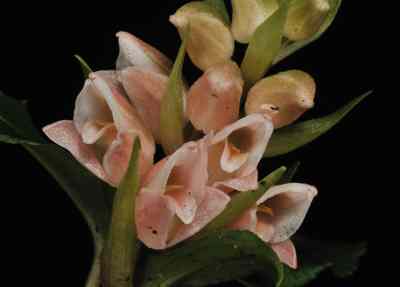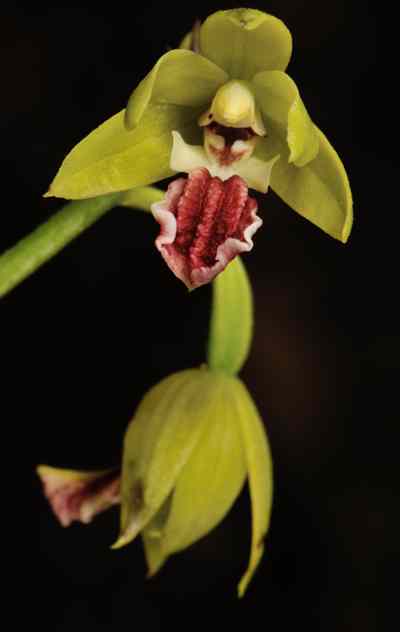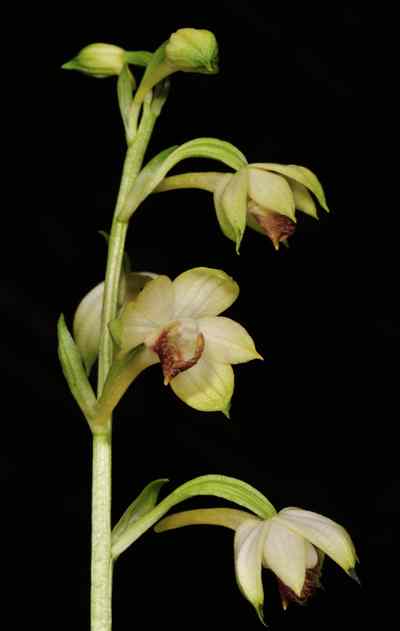The Plant
Terrestrial. A single stemmed plant of the height between 35 to 50 cm. Roots many, stout and 4 to 5 cm long with a very small sheath at the base of the stem. Stem cylindrical, puberulous. Leaves 4 to 6, unequal, broadly elliptic to sub-orbicular, sessile, many nerved, sheathed, 2 to 5 cm long and 1.5 to 3 cm in width at its wider portion. Flower many in a peduncle.
The Flower
Flowers large 1.5 to 2 cm across. Sepals unequal, broadly lanceolate, 3 to 5 veined with the mid one prominent; dorsal sepal smaller than the lateral, arching, acuminate, keeled; lateral sepals larger than the dorsal, spreading, acute, its tip pointing diagonally downwards. Petals slightly longer than the dorsal sepal but shorter than the lateral sepals; lanceolate, acuminate, irregularly veined, diagonally erect and slightly arching forward. Lip as long as the petals; its epichilec ordate, bend downwards with irregular margins and two globose calli at its base; hypochile globularly saccate. Flowers with unusually broad stigma. Floral bract long and narrow, diminishing in length upwards, 2 to 5 cm long, lanceolate, veined, arising from the lower side of the stalked and arching ovary.
Sepals and petals green. The outer portion of the hypocile of the lip is green with pale purple tinge throughout out, the two calli on the base of the epichile are purplish green. The inside of the saccate hypocile is dark purple. Column greenish yellow with orange red margins. Floral bract green.

The Pursuit
A species never documented from the region after its mention in the monumental work of Sir. George King and Robert Pantling. As usual, many authors wrote about this species merely copying the text from the monumental work. Hence, the description of this species remained almost unchanged for more than a century.
During the inception of my work I had decided to put more time and energy in finding all those species, which were not documented in the last century. This species was at the top of that list. The only reference was that it was reported growing at 11,000 ft and flowers in the month of July. The month of July I used to concentrate on alpine hills and I was looking for this species there. Even after surveying huge areas in the month of June and July there was no trace of this species. Those days are unpredictable in the hills with heavy monsoon, flash floods and roadblocks. To make movement more difficult, a glacier burst washed away a bridge of the main road to the alpine region and all vehicular traffic came to a standstill. As the road is of high strategic value, the army’s engineering wing started rebuilding at a quick pace. As they were transporting bridge building equipment in large trucks, every day I found a little place for myself on the steel girders on those military trucks!!! The location of my search area, a towering mountain, was between 11,000 to 13,000 ft and was more than 17 kilometers away from that damaged bridge. As there were no vehicles plying on the other side of the damaged bridge I regularly walked than stretch. Every day I had to climb up the mountain, do my survey and return to the damaged bridge before the last vehicle with personnel returns to their base. Hence, there was no room for any miscalculations; every step had to be timed perfectly. To the surprise of all we got a few sunny days in the hills that week. I was on a routine trip and by afternoon I was descending the hills. I took a short cut through thickets of Rhododendrons. Those Rhododendrons grow so close by; walking through them was very hard. However, to save some time and distance I took that hard path. While negotiating the Rhododendron thickets I found a small plant of this species with few leaves. On close observation I understood that the plant was a mature one and its upper flowering portion had broken off. As I haven’t seen this species earlier or never got a chance to see a photograph of it I was not able to identify it. Expecting more of the species I searched under those Rhododendrons thickets. Time was ticking and I knew I will be missing the vehicle for my return journey. But, the eagerness in me made me continue my search. Those thickets never allowed easy movement. Finally, after around 40 minutes of search I found three plants of this species. Flowers in two of them had withered and one with almost fresh flowers. Finally, after more than a century the species stands in front of an explorer. It is a once in a life time moment and I have no words to express my joy. In the thrill of that moment I had forgotten about the vehicle or how I would reach my base camp. My only thoughts were to document those flowers to the best of my ability. I was there till sunset studying and documenting the plant. I walked back under the shadow of the setting sun and through the darkness of the night for 36 kilometers and reached my base camp at 2 minutes passed midnight.
Reference:
King, G. &Pantling, R. (1898). The Orchids of the Sikkim-Himalayas. Ann. Roy. Bot. Garden. (Calcutta). Epipactis latifolia All., Page no 271/272.







